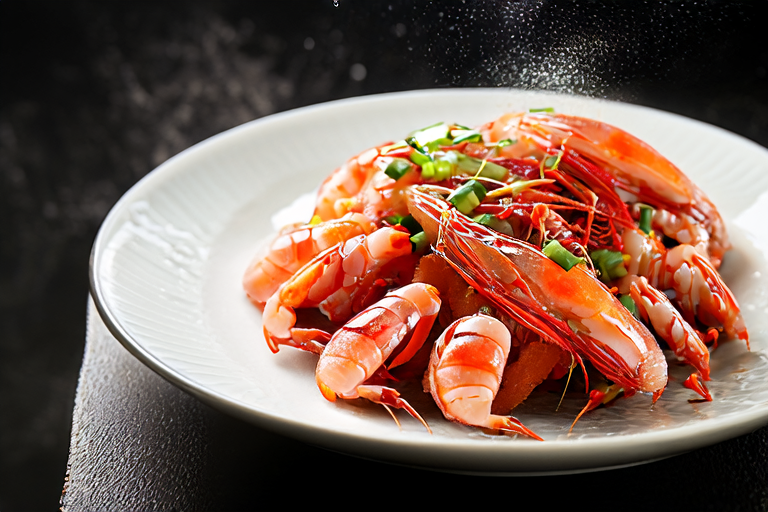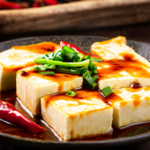Sautéed River Shrimp in Zhejiang Style
Introduction:
Zhejiang cuisine is one of the Eight Great Cuisines of China, renowned for its delicate flavors and meticulous preparation. This recipe showcases Sautéed River Shrimp in Zhejiang Style, a dish that highlights the freshness and natural sweetness of river shrimp while incorporating the signature techniques of Zhejiang culinary arts.
Ingredients:
- 400 grams of fresh river shrimp
- 2 tablespoons of cooking oil
- 1 tablespoon of ginger slices
- 2 cloves of garlic, minced
- 1 tablespoon of Shaoxing rice wine
- 1 teaspoon of sugar
- 1 teaspoon of salt
- 1/2 teaspoon of white pepper powder
- 1 tablespoon of soy sauce
- 1 tablespoon of oyster sauce
- 1 tablespoon of sesame oil
- 1 tablespoon of cornstarch mixed with water (for thickening)
- Garnish: chopped green onions and cilantro
Preparation:
- Preparation of River Shrimp: Rinse the shrimp thoroughly under cold running water to remove any sand or impurities. Pat them dry with paper towels. Remove the heads if desired, and peel off the shells but leave the tails intact for presentation. Make a shallow cut along the back of each shrimp to facilitate even cooking and enhance flavor absorption.
- Marination: In a bowl, combine the peeled shrimp with Shaoxing rice wine, half a teaspoon of salt, and a pinch of white pepper powder. Mix well and let it marinate for about 15 minutes to infuse the shrimp with the aromas of the marinade.
- Preparation of Sauce: In another bowl, mix together soy sauce, oyster sauce, sugar, remaining salt, and white pepper powder. Stir until the sugar is fully dissolved. Set aside.
- Cooking: Heat the cooking oil in a wok or large skillet over medium heat. Add the ginger slices and minced garlic, stirring frequently until fragrant. Be careful not to burn the garlic as this can impart a bitter taste.
- Sautéing the Shrimp: Increase the heat to high and add the marinated shrimp to the wok. Stir-fry quickly, ensuring that the shrimp are evenly coated with the hot oil. The shrimp should turn pink within a minute or two. Once cooked, transfer the shrimp to a plate and set aside.
- Preparing the Sauce: Pour out most of the oil from the wok, leaving just enough to prevent sticking. Return the wok to medium heat and add the prepared sauce mixture. Cook for about 2-3 minutes, stirring continuously to ensure the flavors meld together.
- Thickening: Gradually stir in the cornstarch mixture to thicken the sauce. Continue cooking until the sauce reaches the desired consistency, which should be slightly glossy and thick enough to coat the back of a spoon.
- Combining: Return the sautéed shrimp to the wok and toss gently to coat with the sauce. Add a splash of sesame oil for extra aroma and flavor. Cook for an additional 1-2 minutes to ensure the shrimp are fully heated through and the flavors are well integrated.
- Garnishing: Serve the sautéed river shrimp garnished with chopped green onions and cilantro. This adds both color and a fresh, herbaceous note to the dish.
Cooking Tips:
- Choose fresh, live river shrimp for the best flavor and texture. They should have clear eyes and firm bodies.
- The key to this dish is quick cooking to retain the shrimp’s natural sweetness and tenderness. Overcooking can lead to rubbery shrimp.
- Adjust the seasoning according to your personal taste. If you prefer a stronger flavor, you can increase the amount of soy sauce or oyster sauce.
- The sauce should be slightly thickened but still flowable. Avoid making it too thick as it may overpower the natural flavors of the shrimp.
Nutritional Information:
Per serving (assuming 4 servings):
| Calories | Protein | Fat | Saturated Fat | Carbohydrates | Fiber | Sugar | Sodium |
|---|---|---|---|---|---|---|---|
| 250 kcal | 30 g | 10 g | 2 g | 15 g | 1 g | 5 g | 600 mg |
Conclusion:
Sautéed River Shrimp in Zhejiang Style is a delightful dish that captures the essence of Zhejiang cuisine with its harmonious blend of flavors and textures. The dish is not only visually appealing but also a treat for the palate, offering a perfect balance between savory and sweet. Whether you’re a seasoned chef or a beginner in the kitchen, this recipe is sure to impress your guests and satisfy your cravings for authentic Chinese cuisine.


